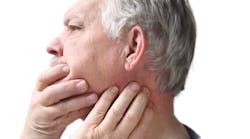What is fascia?
Fascia is a thin casing of connective tissue that surrounds and anchors every organ, blood vessel, nerve fiber, and muscle in our body, spanning from our tongue all the way down to our toes. Comprised of a network of nerves, fascia is almost as sensitive as our skin and is responsible for an individual’s range of motion.1
In oral health care, it is particularly relevant when discussing the myofascial connection to head and neck abnormalities such as tongue restrictions, forward head posture, neck pain, and temporomandibular disorder (TMD). When evaluating a patient with these symptoms, it’s important to consider what influence fascial release may have on all body systems—especially because fascia doesn’t just affect one organ independently.
Tethered oral tissues
Dentists should understand the relationship between tongue posture and adequate craniofacial development, breathing, swallowing, and speech. Tongue mobility is influenced by the length and thickness of the lingual frenulum—anteriorly or posteriorly—and reaches from the ventral surface of the tongue to the floor of the mouth.
With sleep-disordered breathing, the tongue’s inability to reach the palate and rest fully into this space places a patient at risk of their tongue collapsing into the pharynx and occluding the airway.2 To increase tongue mobility, practitioners may want to consider a complete or partial frenectomy as a treatment option.
The difference between these procedures is that a partial frenotomy involves snipping the connective tissue with scissors (often leaving the fascia untouched) while a complete frenectomy typically utilizes a laser that allows a full release of the frenulum through the fascia.2 Being able to cut through the fascia is critical when striving to achieve complete range of motion of the tongue. Although this is a limiting factor when it comes to treatment outcomes, myofunctional therapy is imperative when treating tethered oral tissues.
Temporomandibular disorder (TMD)
It’s clear how fascia restricting the tongue can influence tongue mobility, but what about its effect on TMD? Second to arthritis, TMD is one of the most common musculoskeletal disorders that contributes to pain in the temporomandibular joints (TMJ) and masticatory muscle function.4 Oral health- care professionals understand TMD can stem from a variety of sources, including trauma, hormonal influences, occlusal factors, and muscle hyperfunction.4
However, they also acknowledge the potential role of underlying fascia connecting the musculature as a contributing factor to TMD. When the tongue cannot adequately reach the palate, the surrounding muscles connected to the hyoid bone strengthen as a compensation for the tongue, which can lead to feelings of tension under the jaw and chest.
Additionally, the tongue and jaw supporting the hyoid bone can experience more disproportionate pulling or retraction during use.5 Parafunctional habits have been linked to limited tongue mobility; the tongue is typically responsible for releasing hormones when it contacts the palate.6 If it is unable to do this (and hormone release is not occurring), children often develop habits such as teeth clenching, nail/lip/cheek biting, digit sucking, and object biting.7,8 Studies have shown that patients with TMD-related pain exhibited a higher frequency of these habits. This is due to overused masticatory muscles, which leads to increased muscle tension.
In a recent study evaluating the effect of lingual frenuloplasty and orofacial myofunctional therapy (OMT) on singers and professional speakers with ankyloglossia, participants reported diminished jaw tension/tightness, shoulder muscle relaxation, improved diaphragmatic breathing, reduced facial pain and tightness while singing, and feelings of fascial release from the neck down to the lower back after undergoing functional frenuloplasty treatment.8 This research shows a possible connection between tongue mobility and tension in head and neck muscles and the impact fascial release may have on other body systems.
When I think of fascia constriction, I picture a marionette whose movements are controlled by strings. Thus far, we have seen what an impact restricting fascia can have on tongue mobility and TMD, but when fascia is restricted in certain areas of the body, we tend to compensate for this lack of mobility through our posture. During child growth or fetal development, the tongue can change posture, altering systemic tensions by fascial or trigeminal connections.10 If significant fascial restriction exists, tension on the head and neck muscles could noticeably affect the way we carry ourselves. In the study mentioned earlier, one participant identified improvements in her posture and no longer felt like she was being pulled forward after she underwent functional frenuloplasty.3 Forward head posture, for example, is often seen as a compensation mechanism to pull the jaw forward and open the airway space.11 Additionally, when the tongue rests low in the mouth, it forces the jaw to move downward and backward, which can put pressure on the pharynx. To achieve this postural change, other muscles in the body are utilized. The sternocleidomastoid muscle forces the rib cage to elevate, consequently compromising the function of the thorax and diaphragm.11 Another study evaluated mouth breathing and forward head posture on the respiratory biomechanics and exercise capacity in a group of 92 children. Results found that 32% participants breathed through their mouth—and among those who identified as mouth breathers, 96% had forward head posture.11 Going back to the marionette analogy, tension on the head pulls the rest of the body downward, all the way to the toes. Without proper alignment, tongue-related fascia restriction can have lasting impacts on forward head posture and body compensations as soon as a child begins to walk. Addressing fascial constriction does not always involve surgery; there are myofascial release providers that manipulate stiff areas or trigger points on the body through strategically applied pressure. However, the impact of fascia restriction through the frenulum can have a domino effect on other body systems. When treating a patient with these symptoms, it is important to consider the role of fascia and explore potential solutions to alleviate these concerns. Addressing and treating root causes of mouth breathing, bruxism, TMD, migraines, and postural changes elevates the standard of oral care and may have a lifelong impact on a patient’s overall health. Muscle pain: It may actually be your fascia. Johns Hopkins Medicine. https://www.hopkinsmedicine.org/health/wellness-and-prevention/muscle-pain-it-may-actually-be-your-fascia Baxter R, Merkel-Walsh R, Baxter BS, Lashley A, Rendell NR. Functional improvements of speech, feeding, and sleep after lingual frenectomy tongue-tie release: a prospective cohort study. Clin Pediatr (Phila). 2020;59(9-10):885-892. doi:10.1177/0009922820928055 Yoon AJ, Zaghi A, Ha S, Law CS, Guilleminault C, Liu SY. Ankyloglossia as a risk factor for maxillary hypoplasia and soft palate elongation: a function-morphological study. Orthod Craniofac Res. 2017;n.v:1-8. Kim SR, Chang M, Kim AH, Seong TK. Effect of botulinum toxin on masticatory muscle pain in patients with temporomandibular disorders: a randomized, double-blind, placebo-controlled pilot study. Toxins (Basel). 2023;15:1-12. Summersgill I, Nguyen G, Gray C, et al. Muscle tension dysphonia in singers and professional speakers with ankyloglossia: Impact of treatment with lingual frenuloplasty and orofacial myofunctional therapy. Int J Orofacial Myology Myofunct Ther. 2023;49(1):1-8. Ferrante An, Ferrante A. Finger or thumb sucking. New interpretations and therapeutic implications. AAMS. 2015;67(4):285-297. Cioffi I, Landino D, Donnarumma V, Castroflorio T, Lobbezoo F, Michelotti A. Frequency of daytime tooth clenching episodes in individuals affected by masticatory muscle pain and pain-free controls during standardized ability tasks. Clin Oral Inves. 2017;21:1139-1148. Baeshen HA. Malocclusion trait and the parafunctional effect among young female school students. Saudi J Biol Sci. 2021;28:1088-1092. Mehdipour A, Aghaali M, Janatifar Z, Saleh A. Prevalence of oral parafunctional habits in children and related factors: an observational cross-sectional study. Int J Clin Pediatr Dent. 2023;16(2):308-311. Bordoni B, Morabito B, Mitrano R, Simonelli M, Toccafondi A. The anatomical relationships of the tongue with the body system. Cureus. 2018;10(12):1-7. Okuro RT, Morcillo AM, Goncalves MA, et al. Mouth breathing and forward head posture: effects on respiratory biomechanics and exercise capacity in children. J Bras Pneumo. 2011;37(4):471-479. Posture
Conclusion
References
Annie Walters, MSDH, RDH, attended Northern Arizona University, where she spent time caring for individuals in Guatemala and Indian Health Service. She has a special interest in advancing access to care for individuals with specialized health-care needs. She’s a member of ADHA, and received her MS from the University of New Mexico, where she developed a chairside resource for RDHs to use for patients with specialized needs. She practices in Flagstaff, Arizona, and serves as part-time faculty at her alma mater. Contact her at [email protected].









